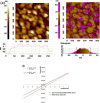Recent advances in the utilization of polyaniline in protein detection: a short review
- PMID: 36425199
- PMCID: PMC9667783
- DOI: 10.1039/d2ra05893f
Recent advances in the utilization of polyaniline in protein detection: a short review
Abstract
Various reports have been published based on covalently attaching biomolecules to polyaniline (PANI). The functional groups connected to the surface of polymeric units determine the immobilization method as well as the method of detection. The present mini-review aims at covering recent advances in the field of protein binding and detection using PANI. Several proteins have been attached to the polymer using different immobilization techniques. The application of PANI in protein detection has also been discussed along with the future scope of these materials in diagnosis and detection.
This journal is © The Royal Society of Chemistry.
Conflict of interest statement
There are no conflicts to declare.
Figures
















References
-
- Shi L. Xiao Y. Willner I. Electrical contacting of glucose oxidase by DNA-templated polyaniline wires on surfaces. Electrochem. Commun. 2006:1057–1060.
Publication types
LinkOut - more resources
Full Text Sources
Other Literature Sources

